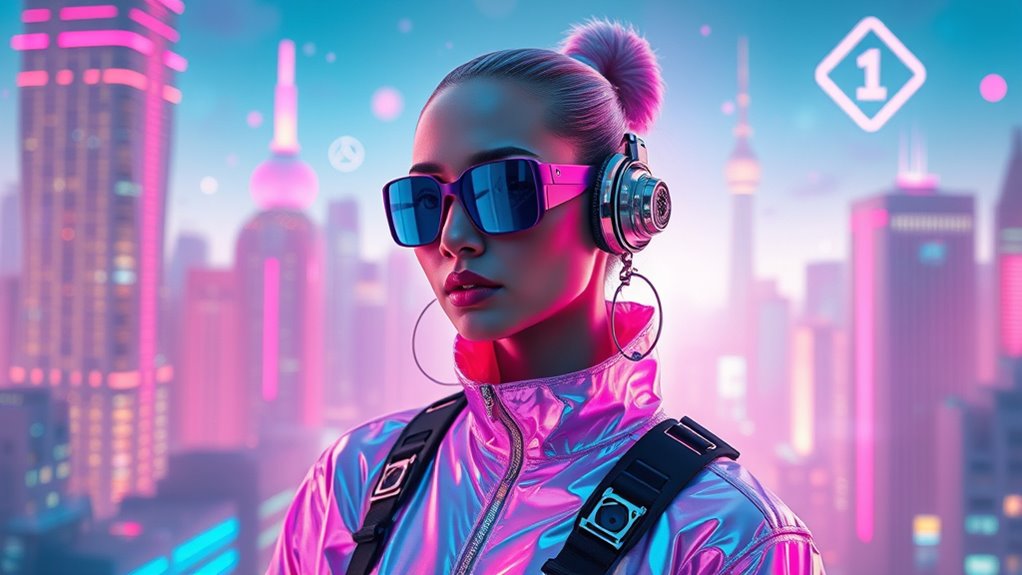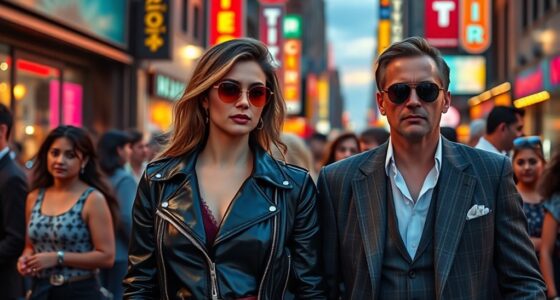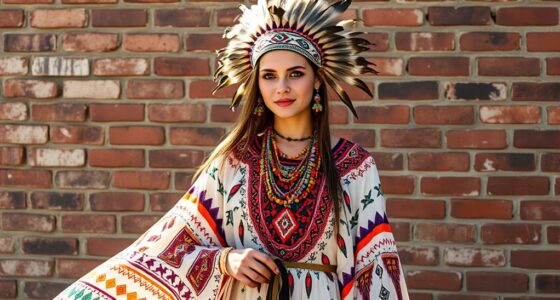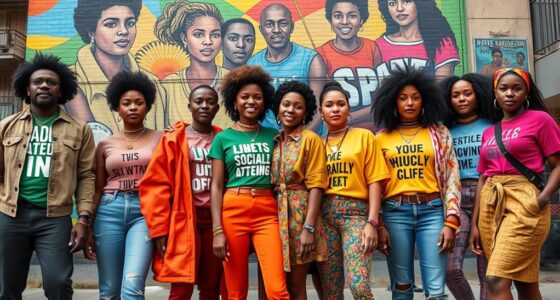Fashion in the metaverse is shaping a new digital style revolution where you can personalize your avatars with virtual wardrobes, participate in immersive runway shows, and connect with influencers shaping trends. Blockchain and NFTs guarantee your digital fashion is secure and ownable, while virtual events promote sustainability and creativity. As virtual identities grow, new opportunities and challenges arise for authentic self-expression. Keep exploring to discover how this digital cultural shift is transforming how you style yourself online.
Key Takeaways
- Virtual fashion in the metaverse enables personalized avatar styles, fostering self-expression and digital identity.
- Immersive virtual shows and boutiques showcase innovative designs, integrating augmented reality and interactive experiences.
- Collaborations between celebrities, designers, and virtual influencers drive trendsetting and cultural influence.
- Blockchain and NFTs ensure secure ownership, authenticity, and monetization of digital fashion assets.
- Future virtual fashion integrates dynamic, adaptable garments and wellness practices, shaping new aesthetic and social paradigms.
The Rise of Virtual Wardrobes and Customization
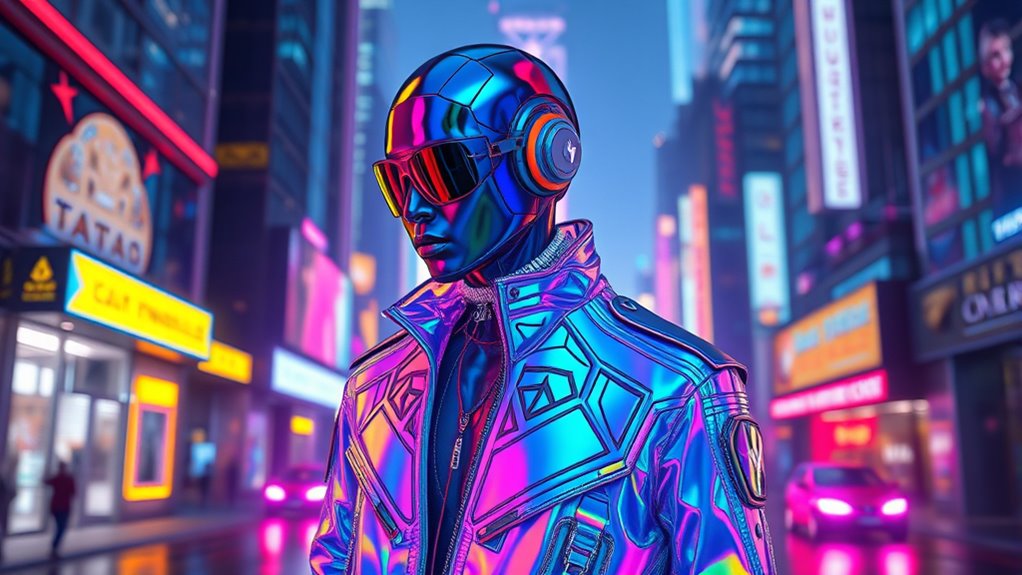
As virtual worlds become more popular, virtual wardrobes and customization options are booming. You now have the ability to express your unique style through avatar personalization, shaping your digital identity with countless options. Virtual wardrobe curation lets you select outfits that reflect your mood, personality, or creativity, making your avatar truly your own. These immersive environments empower you to experiment with different looks without physical constraints, giving you endless possibilities for self-expression. The focus on customizing every detail—from clothing and accessories to hairstyles—enhances your connection to the virtual space. The versatility of hybrid design allows for seamless transitions between styles, further enriching your digital fashion experience. Incorporating space maximization strategies can help manage your virtual assets efficiently, making your digital wardrobe organized and accessible. Understanding how to maximize virtual storage can further optimize your experience, ensuring your collection is both extensive and manageable. As a result, your digital wardrobe becomes an extension of yourself, blending fashion with technology to create a personalized, engaging experience.
Digital Runways: Fashion Shows in Virtual Spaces
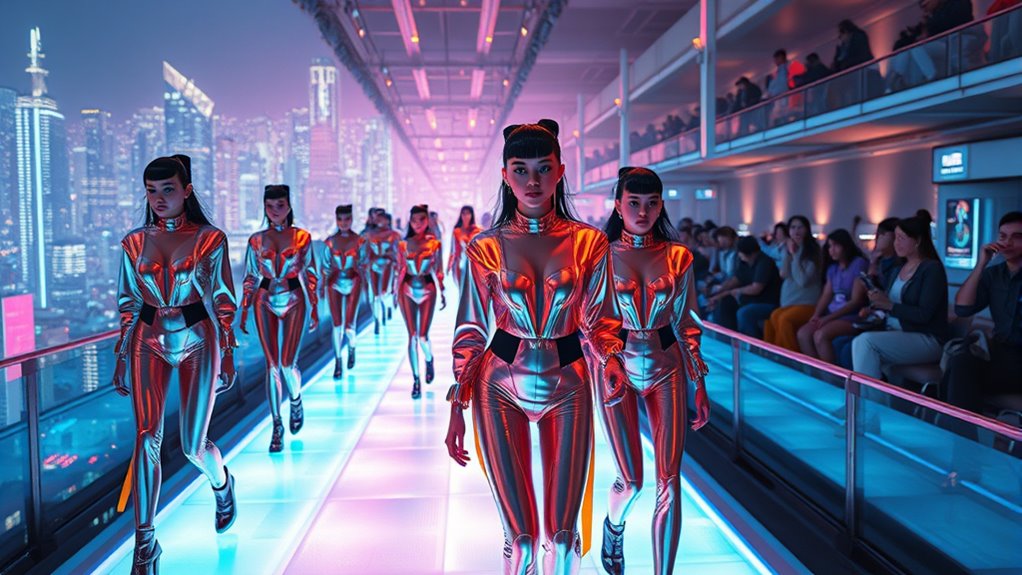
Digital runways are transforming how fashion is showcased, offering immersive experiences that go beyond traditional catwalks. You can now attend virtual shows using augmented reality, making it feel like you’re right there with models strutting in stunning digital environments. Virtual boutiques host these shows, providing instant access to new collections. These virtual spaces allow designers to push creative boundaries, blending art and technology seamlessly. Furthermore, virtual fashion enables sustainable practices by reducing the need for physical samples and travel, minimizing the environmental impact of fashion shows. This innovative approach also emphasizes digital craftsmanship, showcasing intricate digital designs that require advanced technical skills. Below is a quick look at some features:
| Feature | Benefit | Example |
|---|---|---|
| Augmented Reality | Enhances viewer immersion | Virtual front-row seats |
| Virtual Boutiques | Offers instant shopping during shows | Digital runway shopping |
| Interactive Shows | Engages audiences actively | Customizable experiences |
This evolution makes fashion shows more accessible, engaging, and innovative than ever before. This shift in presentation methods is redefining how audiences experience fashion and interact with designers.
Influencers and Creators Shaping Virtual Style Trends
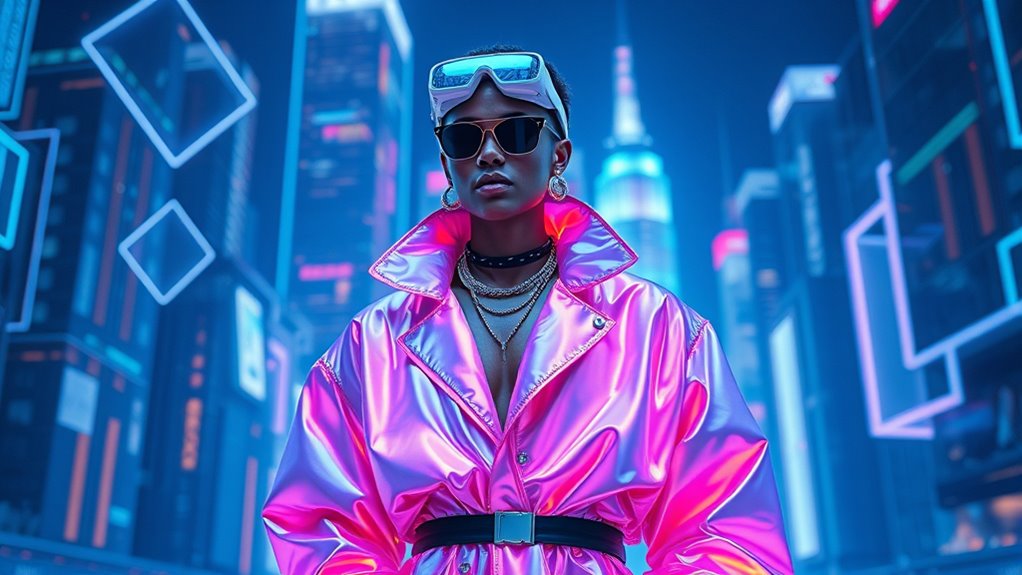
Influencers and creators are quickly becoming the go-to voices for virtual style trends, shaping what users wear in the metaverse. Virtual stylist icons and trendsetting digital creators set new standards, inspiring countless followers. Their collaborations expand the possibilities, making virtual fashion more diverse and innovative than ever before. Additionally, many are incorporating fun elements like playful accessories and patterns, such as acne patches, to personalize digital outfits and boost user confidence. Recognizing the importance of asset division principles, these creators often share insights into fair distribution of digital assets, influencing how virtual property and fashion items are valued and exchanged. Understanding ethical hacking concepts can also help protect creators’ intellectual property and digital assets from malicious threats, ensuring a safer virtual environment.
Virtual Stylist Icons
Virtual stylist icons are transforming how we define and follow fashion trends in the metaverse. These influencers and creators set the pace for virtual style, often showcasing innovative avatar customization and endorsing virtual fashion brands. They influence millions, shaping what’s popular in digital spaces and inspiring you to experiment with your own virtual look. Their unique styles and bold choices help normalize diverse expressions of identity and aesthetics. Whether through TikTok, Instagram, or virtual worlds, these icons push boundaries and spark trends, making virtual fashion more accessible and exciting. Moreover, leveraging AI-driven analysis allows these creators to stay ahead of emerging trends and refine their content strategies for even greater impact. As AI technology continues to improve, it also enables a deeper understanding of virtual culture and audience preferences, further empowering these trendsetters. This ongoing innovation ensures that virtual fashion remains a dynamic and ever-evolving digital landscape.
Trendsetting Digital Creators
As trendsetting creators take center stage in the metaverse, they shape the future of digital style with their bold ideas and innovative content. These influencers lead the way in avatar customization, turning virtual appearances into powerful expressions of identity and creativity. They push boundaries by designing unique outfits and experimenting with digital fashion entrepreneurship, transforming how style is perceived online. Through their content, they inspire millions to adopt new trends and explore their virtual selves. These creators don’t just follow fashion—they set it, leveraging platforms that reward originality and flair. By doing so, they influence not only virtual communities but also the broader digital culture, making them pivotal in evolving the metaverse’s fashion landscape. Their ability to incorporate digital fashion into everyday virtual interactions further cements their role as trendsetters, especially as the industry continues to grow and innovate with virtual clothing and accessories. A key aspect of their influence is how they utilize virtual style to craft unique identities that resonate across digital spaces.
Influencer Collaborations Expand
The rise of influencer collaborations has substantially amplified the impact of creators shaping virtual style trends. By forming brand partnerships, influencers and celebrities now influence virtual fashion at an unprecedented scale. These collaborations often feature exclusive digital collections or limited-edition items that resonate with their followers. Celebrity endorsements lend credibility and excitement, encouraging fans to adopt trending styles within the metaverse. As a result, virtual clothing lines gain rapid popularity, and brands see increased engagement through influencer-driven campaigns. This synergy between influencers and brands accelerates the evolution of digital style, making trends more accessible and immediate. You can expect to see more high-profile collaborations that blend celebrity influence with innovative virtual fashion, pushing the boundaries of what’s possible in the metaverse’s style landscape. Additionally, the integration of music therapy and sound healing practices in virtual environments may influence future virtual fashion aesthetics by promoting holistic wellness and creative expression. Furthermore, the growing recognition of digital culture continues to inspire new ways for creators to merge art, technology, and personal identity within virtual fashion spaces. Moreover, understanding the importance of expert voice actors can enhance how brands communicate these virtual trends effectively to diverse audiences.
Bridging the Gap: Physical and Digital Fashion Collaborations
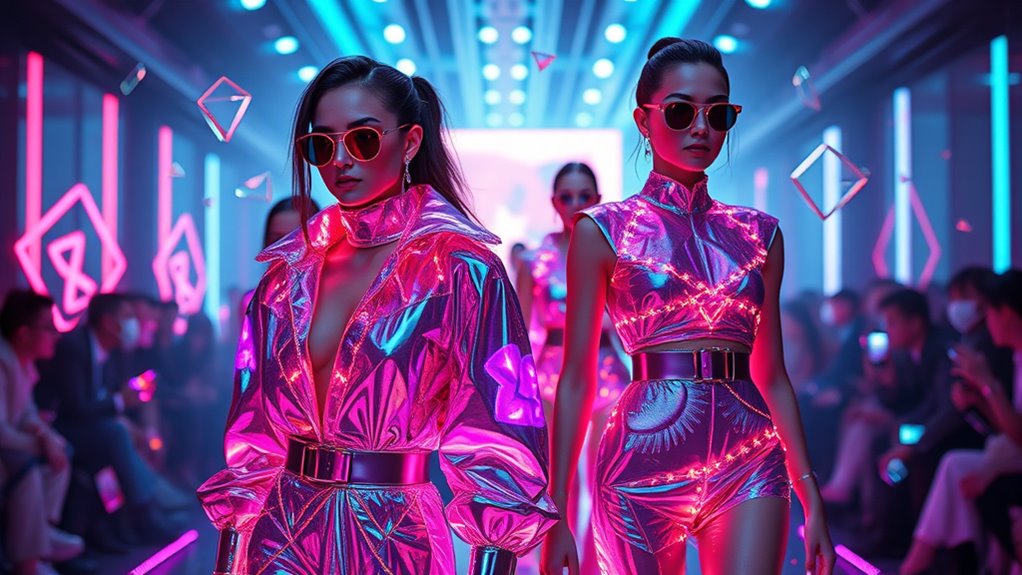
Bridging the gap between physical and digital fashion has become a key focus as brands seek innovative ways to engage consumers across both spheres. Collaborations that integrate tangible garments with virtual experiences allow you to express your avatar’s identity more authentically. For example, brands now create physical pieces that can be translated into digital assets, enhancing avatar expression in virtual worlds. Virtual fitting rooms let you try on digital versions of clothing before purchasing physical items, blending convenience with immersive style. To deepen this integration, consider these approaches:
Bridging physical and digital fashion fosters authentic self-expression and immersive shopping experiences.
- Designing limited-edition physical-digital crossover collections
- Using augmented reality to preview digital accessories with real-world outfits
- Developing exclusive virtual wardrobes tied to physical store purchases
- Incorporating smart textiles that enable physical garments to interact with digital environments
Additionally, integrating eco-friendly materials in both physical and digital fashion can promote sustainability in these innovative collaborations.
These strategies foster seamless interaction between your physical wardrobe and digital self.
The Role of Blockchain and NFTs in Virtual Fashion Ownership
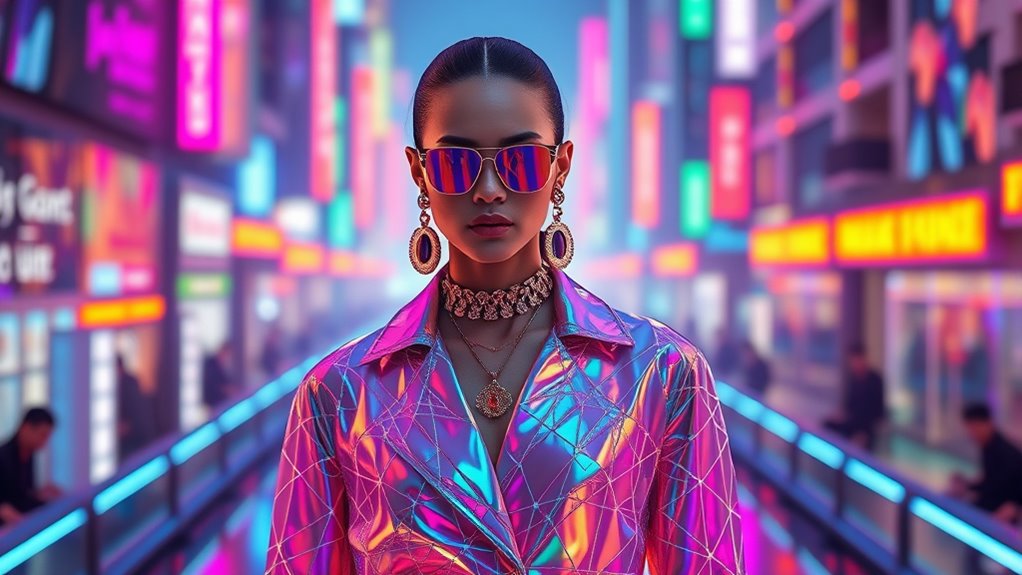
Blockchain technology and NFTs have revolutionized virtual fashion by establishing secure, verifiable ownership of digital assets. With blockchain authentication, you can confidently prove your digital ownership, ensuring that your virtual clothing and accessories are unique and tamper-proof. This technology eliminates concerns about duplication or unauthorized copying, making your digital fashion items genuinely yours. NFTs serve as digital certificates that verify authenticity and provenance, which is essential for collectible virtual fashion. As a result, you gain greater control over your digital wardrobe, and designers can monetize their creations more securely. Additionally, understanding headphone connectivity options can enhance your immersive experience when engaging with virtual fashion in the metaverse. This shift not only enhances trust but also fosters a new economy around virtual fashion, where ownership is transparent, immutable, and easily transferable across platforms. Furthermore, the integration of digital asset management solutions helps streamline ownership and transaction processes in this emerging digital landscape.
Sustainability and Ethical Considerations in Digital Attire
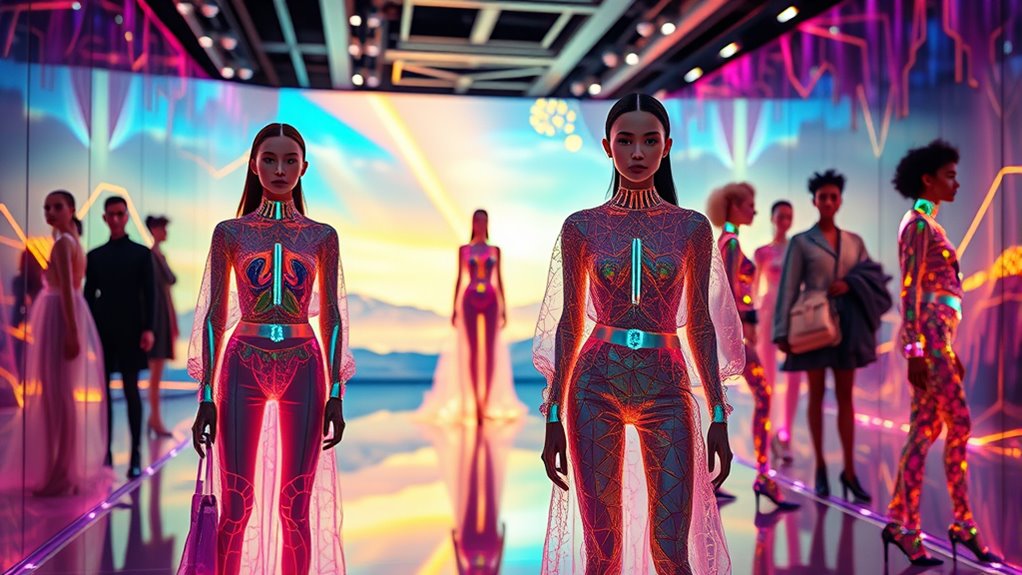
Have you ever considered how digital fashion impacts the environment and ethical standards? Virtual material ethics emphasize creating digital garments with minimal environmental harm, promoting sustainable design principles. As you explore virtual attire, think about digital waste management—reducing unnecessary digital clutter and avoiding data overload. To deepen your understanding, consider these points:
Digital fashion’s ethical impact highlights eco-friendly design and digital waste management strategies.
- The importance of developing eco-friendly virtual materials that minimize energy consumption.
- Ethical responsibilities around digital ownership and avoiding exploitative practices.
- Strategies for managing digital waste, such as deleting outdated or unused virtual assets to reduce server loads.
- Incorporating Best Airless Paint Sprayers into design workflows can inspire sustainable approaches to virtual fashion creation. Additionally, adopting digital sustainability practices can further help reduce the environmental footprint of virtual fashion development.
The Impact of Virtual Fashion on Consumer Behavior
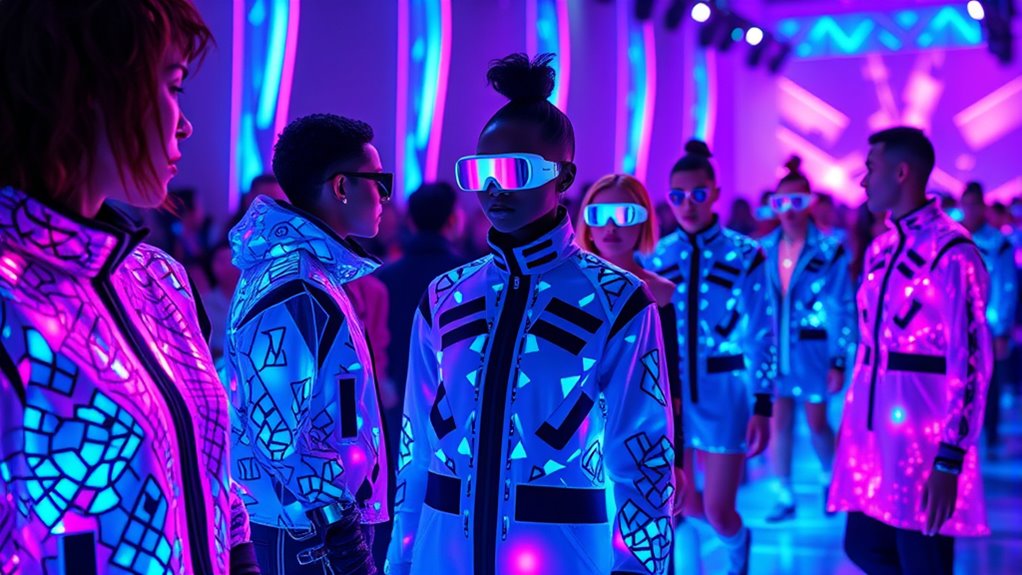
Virtual fashion lets you shape your digital identity and express yourself in new ways. It also influences your purchase habits as you explore trends and unique styles online. Plus, it helps you connect with others and build virtual communities centered around shared fashion interests.
Shaping Digital Identity
As virtual fashion becomes more prevalent, it profoundly influences how you craft and present your digital identity. Your digital avatars become extensions of yourself, showcasing your style choices in virtual spaces. Augmented reality allows you to try on virtual outfits in real time, enhancing personalization and self-expression. These innovations encourage you to experiment with looks you might not wear in real life, shaping your online persona. To deepen this impact, consider these aspects:
- Customizing your avatars to reflect your evolving identity.
- Using augmented reality to preview outfits before adopting them digitally.
- Curating virtual wardrobes that reinforce your personal brand and style.
This evolving landscape empowers you to define your digital presence with authenticity and creativity, making your virtual self as meaningful as your physical one.
Influencing Purchase Trends
Ever wondered how digital fashion is transforming the way you shop and make purchasing decisions? Augmented reality allows you to try on virtual outfits seamlessly from your device, giving you a realistic sense of how items look before buying. Virtual marketplaces make shopping more accessible, offering a vast array of digital garments without physical inventory. These platforms encourage impulsive purchases, driven by immersive experiences and instant gratification. Consumers now prioritize digital exclusives and limited-edition items, influenced by virtual trends and social media hype. Virtual fashion also reduces barriers, making it easier to experiment with styles and buy from global brands. Overall, these innovations are shifting your purchasing behavior toward more spontaneous, informed, and trend-driven decisions in the digital sphere.
Fostering Virtual Communities
Because digital fashion platforms often serve as social spaces, they foster vibrant virtual communities where consumers connect over shared styles and trends. Avatar customization plays a key role, allowing you to express your identity and stand out within these groups. Virtual community engagement encourages interactions, from trading virtual outfits to participating in fashion challenges.
To deepen your involvement, consider these aspects:
- Building unique avatars that reflect your personal style.
- Participating in exclusive virtual events or fashion shows.
- Collaborating with others on limited-edition digital outfits.
These activities strengthen your sense of belonging and influence your purchasing behavior. As communities grow tighter, you’re more likely to explore new styles, invest in virtual fashion, and stay engaged with evolving trends.
Challenges and Opportunities in Virtual Fashion Development
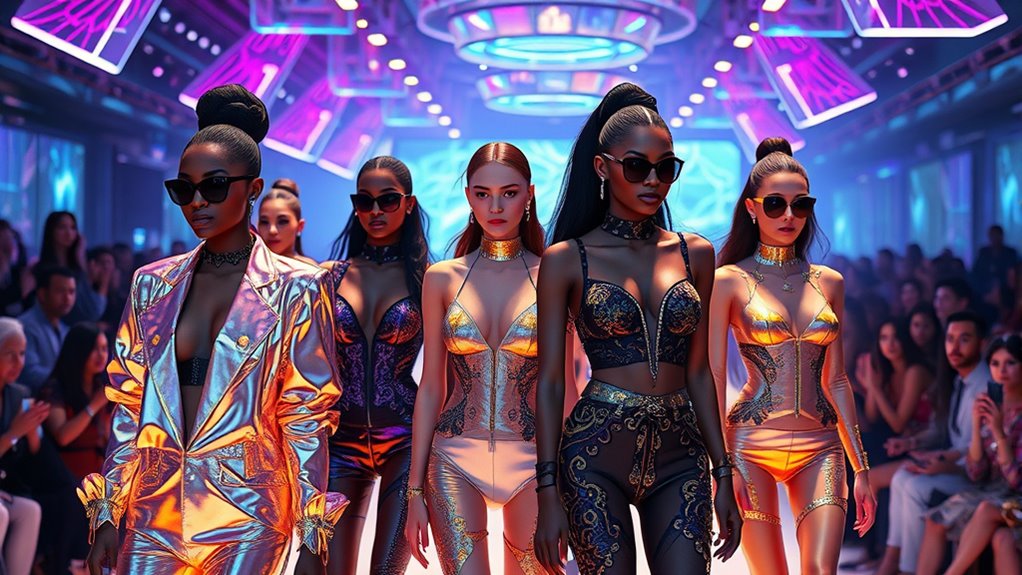
Developing virtual fashion in the metaverse presents both significant opportunities and notable challenges. Technological barriers, like limited device compatibility and graphics quality, can hinder widespread adoption and immersive experiences. You might find it frustrating if your hardware can’t fully support high-quality designs or seamless interactions. Cultural acceptance is another hurdle; some users may view digital fashion as less valuable or merely novelty, making it harder to integrate into mainstream culture. Despite these obstacles, there’s huge potential for innovation, allowing brands to experiment with new styles and personalized expressions without physical constraints. By steering through these technological and cultural challenges, you can help shape the future of virtual fashion—creating more inclusive, engaging, and innovative digital style worlds.
Future Trends: What’s Next for Style in the Digital Realm
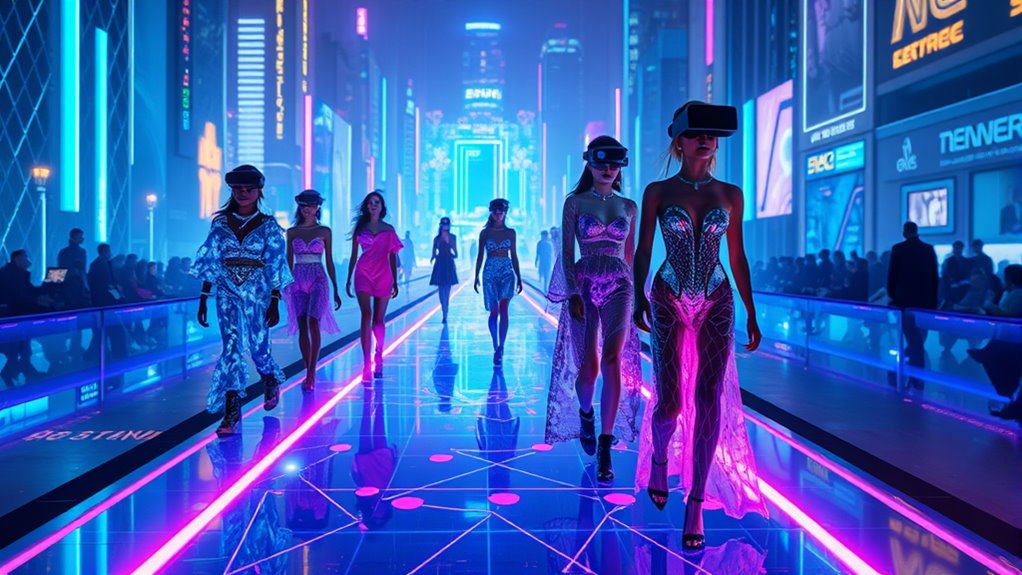
As technology continues to evolve, the future of digital fashion in the metaverse promises exciting innovations that will reshape how you express yourself. Augmented reality will make virtual try-ons seamless, allowing you to see digital outfits in real-world settings. AI stylists will personalize your wardrobe, offering tailored suggestions that match your style and mood. Expect more immersive experiences as virtual fashion becomes more integrated into everyday life.
Here are some key trends to watch:
- Augmented reality shopping experiences that blur the line between physical and virtual fashion.
- AI-driven styling services that create unique, personalized looks instantly.
- Digital garments with dynamic, adaptable designs that respond to your environment or mood.
These advancements will make your digital style more intuitive, personalized, and expressive.
Frequently Asked Questions
How Does Virtual Fashion Influence Traditional Clothing Industries?
Virtual fashion, especially through digital couture and virtual runway shows, reshapes traditional clothing industries by inspiring new design ideas and expanding creative boundaries. You’re influenced as designers experiment with innovative concepts that blend digital and physical styles. This sparks trends, attracts tech-savvy consumers, and pushes brands to embrace digital platforms. As a result, virtual fashion accelerates industry evolution, encouraging traditional brands to adopt digital approaches and stay relevant in a rapidly changing fashion landscape.
What Are the Privacy and Security Concerns in Virtual Fashion Platforms?
Imagine your digital closet, vulnerable to unseen threats lurking behind virtual fabrics. You might share personal details, but data privacy issues threaten to reveal your identity or preferences. Hackers could breach digital security, stealing your virtual assets or manipulating your avatar. In these platforms, safeguarding your information isn’t just important—it’s essential. You need robust encryption and privacy controls to protect yourself from potential breaches and guarantee your virtual experience remains secure and private.
Can Virtual Fashion Be Considered Truly Sustainable and Eco-Friendly?
You might wonder if virtual fashion is truly sustainable. While it reduces physical waste, it relies on digital resource management, which can consume significant energy. Eco-conscious innovation is key; by optimizing servers and promoting virtual designs, you can make digital fashion more eco-friendly. So, yes, virtual fashion has the potential to be sustainable if you focus on efficient digital practices and energy-saving solutions.
How Accessible Is Virtual Fashion for Diverse Global Populations?
Virtual fashion’s accessibility varies, and you might find it limited by the digital divide, which affects many global populations. While it offers opportunities for cultural representation, those without reliable internet or devices may be left out. To truly achieve inclusivity, creators need to take into account diverse needs and make virtual fashion accessible across different regions and tech capabilities, so everyone can participate in this digital style revolution.
What Regulations Govern Intellectual Property in Digital Fashion Creation?
You’d think digital fashion creators would be free to innovate without limits, but regulations like digital copyright and trademark enforcement keep things in check. These laws protect original designs from being stolen or copied, preventing chaos in the virtual marketplace. They’re designed to guarantee creators get credit and control over their work, making sure the digital fashion world stays fair and creative, just like in the physical world.
Conclusion
As you navigate this evolving digital landscape, remember that virtual fashion gently invites you to explore new expressions of style with grace and innovation. Embrace the seamless blend of creativity and technology, knowing that each digital garment offers a subtle shift toward a more sustainable and inclusive future. While changes may quietly unfold, your journey into the metaverse promises a refined canvas for personal artistry—where imagination and elegance harmoniously converge.
